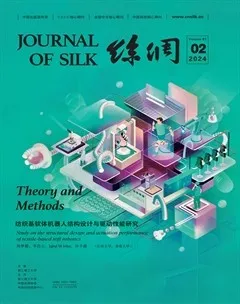新型热防护材料研究进展
2024-03-04项舒琪卢业虎
项舒琪 卢业虎
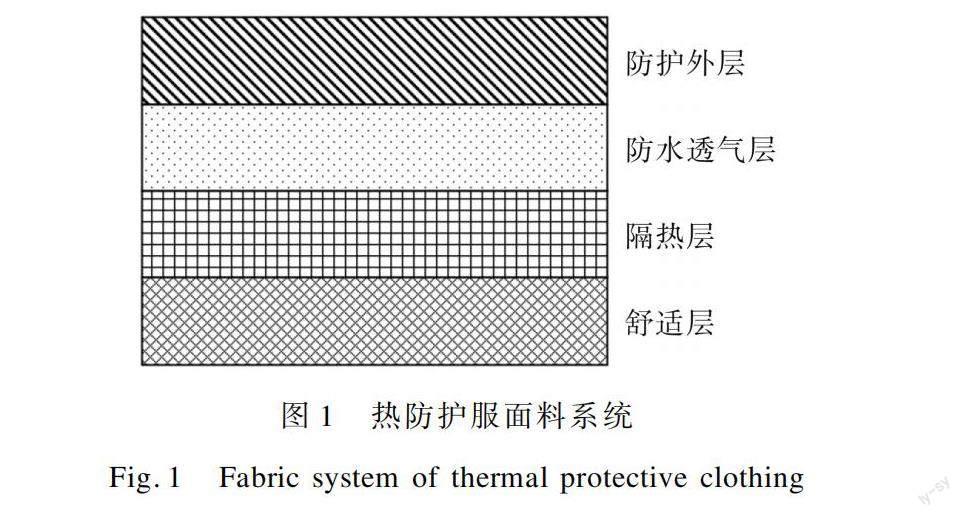
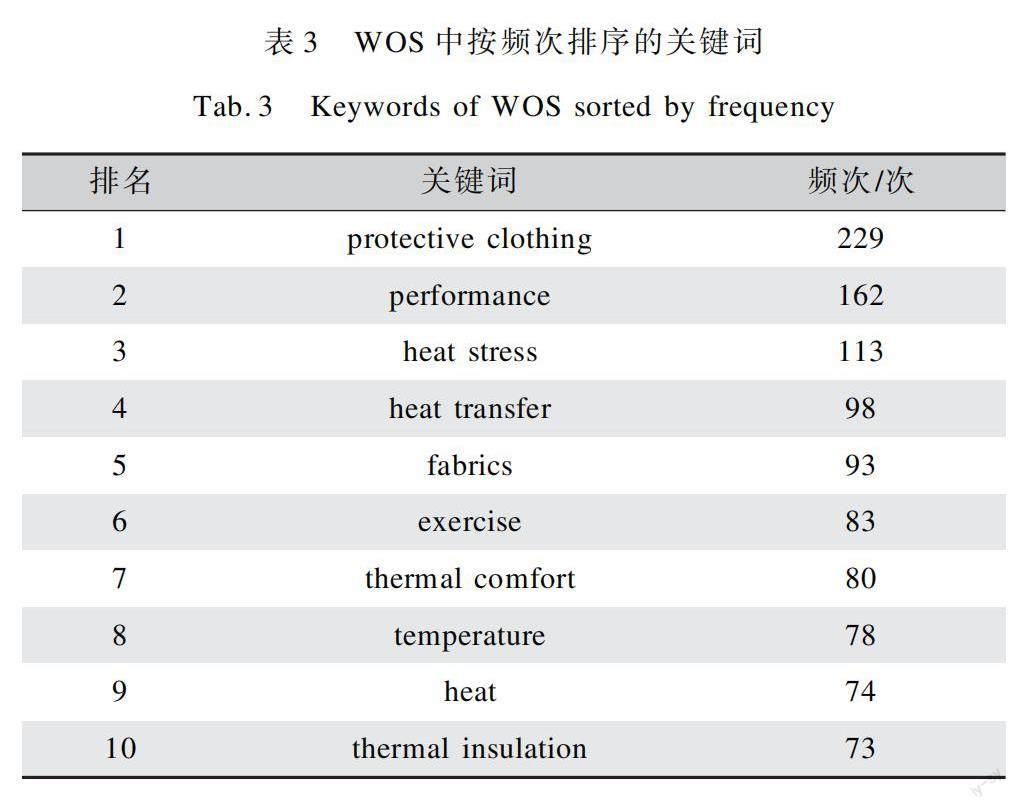




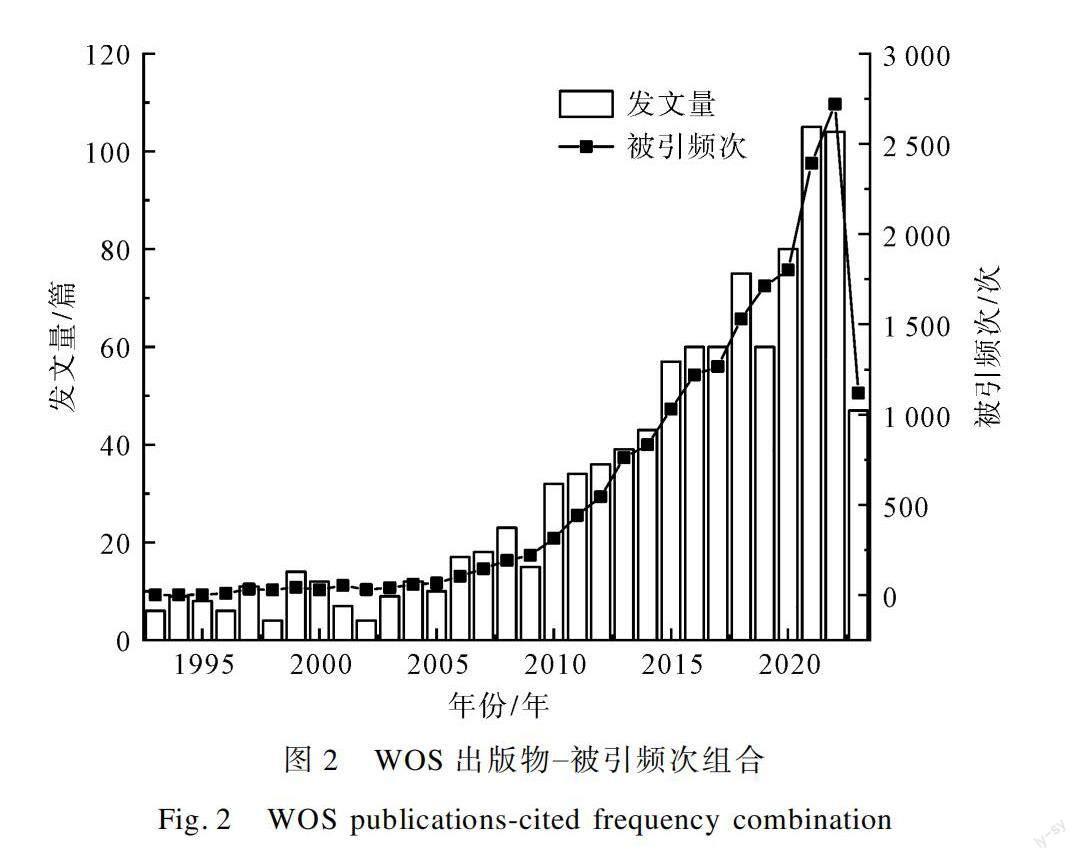
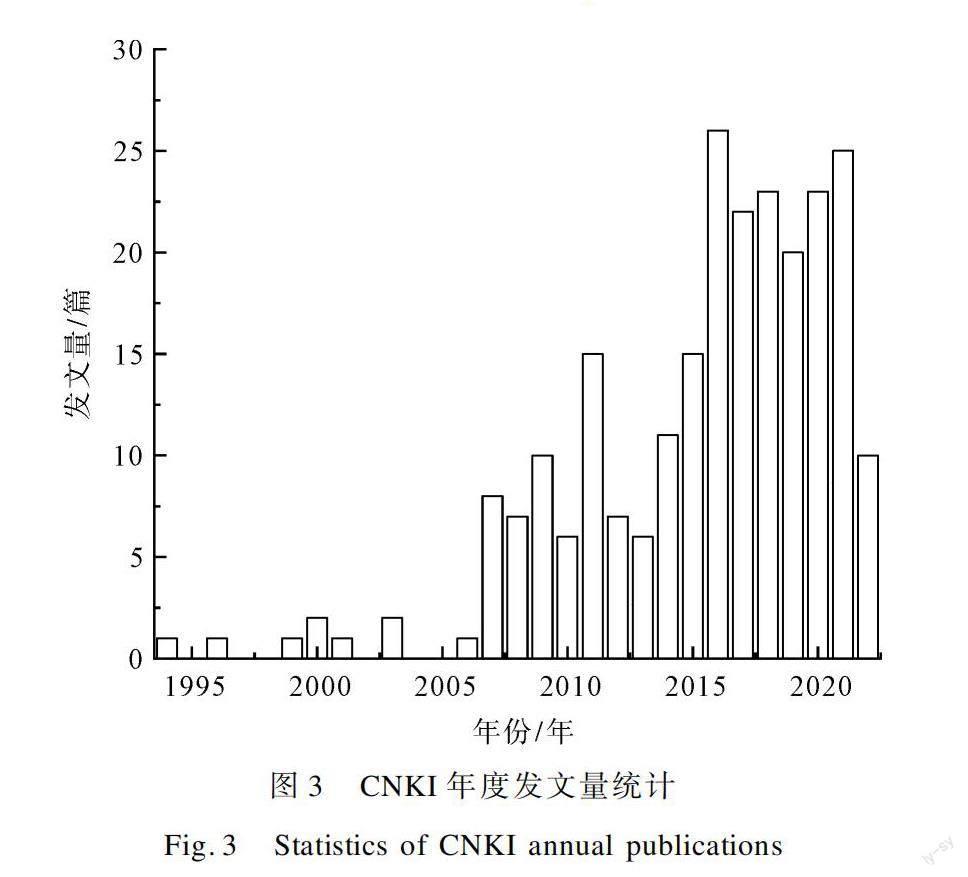

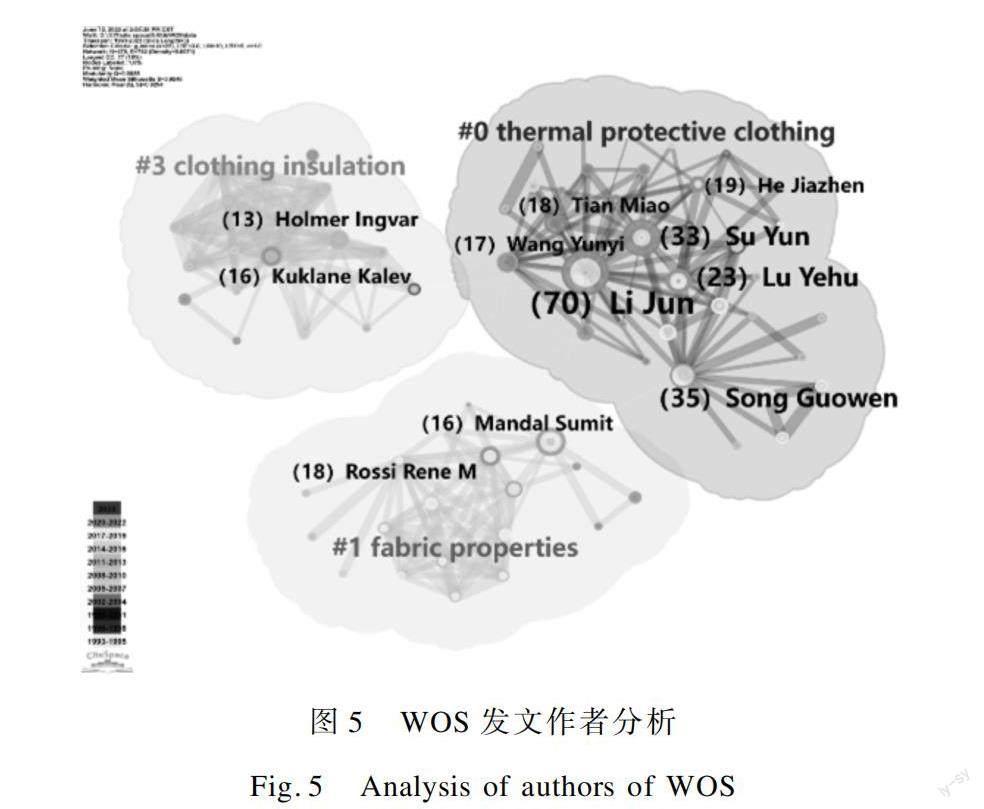

摘要:为分析热防护材料领域研究现状和未来发展趋势,文章采用信息可视化、网络分析的研究方法,以Web of Science(WOS)数据库及中国知网(CNKI)数据库中近30年(1993年1月—2023年6月)热防护材料相关的文献作为数据来源绘制可视化信息图谱,对发文量、发文国家/地区和机构、研究方向、核心作者、关键词等元素逐一进行分析,剖析热防护材料研究领域的发展动态、研究热点及前沿趋势。结果显示,美国、中国为主要研究国家,在该领域居重要地位;LI J(Li Jun)、SONG G W(Song Guowen)、SU Y(Su Yun)、LU Y H(Lu Yehu)、王云仪、朱方龙等作者为该领域的核心作者,在热应激、热防护服的研究中具有重要影响力;热防护服的热防护性与传热机制、人体的热生理与热舒适为活跃的研究主题与研究热点;相变材料、气凝胶、形状记忆织物、蜂窝夹芯织物、三维间隔织物为当前的研究熱点材料,新型热防护材料的研发、服装内部结构的优化是未来研究中有效应对热应激的解决方法,是兼顾热防护服的热防护与热舒适平衡的重要途径。
关键词:热防护材料;CiteSpace;可视化分析;热应激;热舒适;热防护性
中图分类号:TS941.73
文献标志码:A
文章编号:10017003(2024)02009511
DOI:10.3969/j.issn.1001-7003.2024.02.011
收稿日期:20230725;
修回日期:20231219
基金项目:江苏省高等学校基础科学(自然科学)重大项目(21KJA540004);苏州市科技计划项目(SS202147)
作者简介:项舒琪(2000),女,硕士研究生,研究方向为服装舒适性。通信作者:卢业虎,教授,博导,yhlu@suda.edu.cn。
在工业、消防、应急救援等领域,作业人员经常遭受火焰、高温液体、辐射热、高压蒸汽等热灾害威胁,需要穿着特定的热防护服来应对这些危害。环境中的热量通过传导、对流、辐射三种形式在“人体服装环境”系统中传递。以火场为例,火场温度通常可达到400~2500 ℃,热对流和热辐射是主要的传热方式,导致人体产生热应激、皮肤烧伤甚至死亡。热防护服作为保护作业人员生命安全的有效屏障,开发高性能热防护材料及服装具有重要的意义。
欧美国家早在20世纪50年代对热防护服领域开展系统化研究,中国在热防护领域的探索起步相对较晚。早期热防护服的研究侧重于对服装热防护性能的测评,旨在提高服装的热防护性能,但对其舒适性的关注较少。根据现行的行业标准GA 10—2014《消防员灭火防火服》,传统的热防护服由四层结构组成,分别是防护外层、防水透气层、隔热层、舒适层(图1),各层发挥着不同的作用。尽管传统的热防护服已具备良好的热防护性,但其过于厚重,人体在运动过程中,热防护服内部会蓄积热量和水分,穿着时间较长会出现体温升高、心率加快等生理反应,增加作业人员的生理热负荷和热应激,对人体生命安全造成危害。因此,在保证热防护性能的基础上提高热湿舒适性是目前该领域重点关注的研究方向。
热防护性能指标有热防护性能(Thermal Protective Performance, TPP)、二度烧伤时间t、三度烧伤时间t等,用于评定热防护服的热防护性能。热防护服的防护性与舒适性与其使用的材料密切相关,热防护服材料朝着轻质化方向发展。当前有较多国内外学者从事热防护材料方面的研究,有关热防护材料的成果数量与日俱增,但鲜有研究从文献计量学角度对其研究方向和进展进行系统总结。本文采用信息可视化分析软件CiteSpace对热防护材料的研究热点进行分析,深入了解新型热防护材料的研究进展和动态前沿,探讨各类新型热防护材料的研究现状与未来发展趋势,以期为后续的研究提供基础。
1 数据来源与研究方法
1.1 数据来源
本文通过对Web of Science(WOS)核心合集数据库及中
国知网(CNKI)数据库进行文献检索,以热防护材料为检索主题,设置时间跨度为1993—2023年(2023年6月12日)。检索过程中关键参数设置及文献数量如表1所示,共获得文献1 683篇(WOS共1 388篇、CNKI共295篇)。用CiteSpace中的数据处理工具对所下载的数据进行除重,文献检索中最终过滤出文献1 265篇(WOS共1 017篇、CNKI共248篇)。
1.2 研究方法
将检索获得的数据记录导入信息可视化软件CiteSpace V 6.2.R5中,时间参数设置为1993年1月—2023年6月,时间切片为3年,主题词来源使用软件默认全选,选择标准g-index默认值k=25,阈值选择系统默认值Top 50,默认选择不剪枝,节点类型依次选择作者、机构、国家、关键词、被引作者等进行多维度分析。软件生成的图谱中的节点大小和连线颜色表示发文量和所属集群,节点表示所选择的作者、机构、关键词、国家等元素,连线两端元素具有合作关系。
2 文献统计
查看WOS核心合集数据库的“引文报告”分析1 017篇所选文献,获得2 893篇施引文献(去除自引),被引频次达15 002次(去除自引),平均每篇被引频次为18.43次,年度被引频次和发文量如图2所示。1993—2023年,WOS中热防护材料相关文献被引频次和发文数量呈增长态势。在1993—2007年处于平缓发展期,对热防护服材料的研究仍处于起步阶段,研究成果较少;在2007年之后研究成果急剧增加,虽在2018—2019年出现较大幅度的下降,但总体上发文量和被引频次仍处于增长状态。
查看CNKI的“计量可视化分析”分析248篇所选文献,被引频次达2 170次(去除自引),年度发文量如图3所示。1993—2023年,CNKI中有关热防护材料的相关文献数量不断攀升。在1993—2006年趋于平缓,在2007年之后迅速增加,与WOS发文量的趋势相似。根据以上两大数据库的文献统计,表明学术界对热防护材料的关注度不断攀升,作业人员的安全和生命健康问题受到广泛关注。
WOS检索结果分析显示,热防护材料的研究领域广泛,其中排名前三的研究方向为材料科学(47.59%)、工程学(23.30%)、公共环境职业健康(13.47%)。由此可见,热防护材料的研究在多个领域具有广泛应用,运用材料科学和工程学的研究方法在改善公共环境职业健康方面具有重要作用。
3 共引网络分析
3.1 国家、机构合作网络分析
节点的中心性表示各国/地区之间的合作强度与影响力,使用CiteSpace软件对各国/地区之间热防护材料研究的合作网络进行分析(图4),中心性从强到弱的国家依次为美国(0.50,202篇,1993年)、澳大利亞(0.15,63篇,1994年)、英国(0.15,40篇,1996年)、中国(0.14,275篇,2006年),在热防护材料领域有重要影响力。
使用CiteSpace软件分别对WOS数据库和CNKI数据库的发文机构进行分析。在WOS数据库中,热防护材料的主要发文机构为东华大学(0.24,121篇,中国)、中央劳动保护研究所(0.02,37篇,波兰)、瑞士联邦技术研究所(0.04,37篇,瑞士)、瑞士联邦材料科学与技术研究所(0.04,34篇,瑞士)、阿尔伯特大学(0.06,33篇,加拿大)、北卡罗莱纳州立大学(0.04,27篇,美国),中心性最强的发文机构东华大学(中心性0.24)与其他发文机构的学术交流密切,合作关系良好。在CNKI数据库中,热防护材料高产机构有东华大学(58篇)、天津工业大学(33篇)、中原工学院(21篇)、苏州大学(14篇)、浙江理工大学(13篇),其中东华大学发文量最高,影响力最大。
3.2 核心作者分析
3.2.1 发文作者
使用CiteSpace软件对WOS数据库的发文作者进行关键词聚类,如图5所示。所得研究集群为热防护服、服装热阻与织物性能三大类,共涵盖国内外作者共56名,其中发文量排名前5的作者分别为LI J(Li Jun,70篇)、SONG G W(Song Guowen,35篇)、SU Y(Su Yun,33篇)、LU Y H(Lu Yehu,23篇)、ROSSI R M(18篇)。
在WOS数据库的发文作者合作网络三大集群中,最大的集群为热防护服,其主要研究人员为LI J(Li Jun)、SONG G W(Song Guowen)、SU Y(Su Yun)、LU Y H(Lu Yehu),这4位作者之间合作关系紧密,主要研究热防护服的传热、储热、散热,以了解热应激与热生理的关系,降低人体热应激带来的消极影响。其中,LU Y H等通过将形状记忆合金运用于热防护服中,实现空气层的动态调节,提升热防护与热舒适。LI J与SU Y等制备了一种智能双向热调节的PCM涂层织物,有助于开发用于热防护服的高热容量和低放热的PCM材料。SONG G W等通过气凝胶与相变材料的结合应用,为减少热防护服系统的质量和厚度提供新的解决方案。
使用CiteSpace软件得到CNKI数据库中关于热防护材料相关文献发文量排名前5的作者,分别为李俊、苏云、朱方龙、卢业虎、王云仪。其中,李俊、苏云、王云仪的合作关系密切,主要研究热防护服的传热机制,并通过制备阻燃型相变微胶囊涂层织物来提高相变调温防护服的使用安全性。朱方龙通过将相变材料应用于热防护服来研究服装的传热、热防护性能,利用数值模拟研究了相变材料在服装中的位置关系,验证了含相变材料的热防护服应对高温环境温度突变的有效性。卢业虎将石墨烯气凝胶、形状记忆材料分别应用于热防护服面料系统,通过创新热防护服面料达到提升热舒适的目的。
3.2.2 共被引作者
表2为出现频次与中心性分别排名前5的共被引作者。其中,TORVI D A不仅具有较高的被引频次,还具有较强的中心性,其研究内容在热防护领域具有重要价值。早在1994年,TORVI D A开发了多层有限元模型,用于预测模拟闪火条件下的二度和三度烧伤时间;随后,TORVI D A基于小尺寸台式测试建立了由织物到传感器的传热模型,为后续热防护领域传热的研究奠定基础。在前期学者研究的基础上,SONG G W等建立了用于预测低热辐射暴露下消防员热应激的数值模型,为兼顾热防护性能与热舒适性提供新思路。HAVENITH G、HOLMER I、LOTENS W A、PSIKUTA A及NUNNELEY S A主要从事人体热舒适与热平衡方面的研究,减少热应激对人体的伤害。其中,HAVENITH G通过引入热应激指数和模型来量化热应激,有助于降低热应激概率。BARKER R L和LU Y H研究内容广泛,主要研究在热暴露下热防护服的热防护性能及传热和储热等方面的内容。其中,LU Y H等通过在热防护服中引入形状记忆合金,增加热防护服内的空气层厚度,有效延缓二度烧伤时间,为热防护服的热防护与热舒适的研究提供新方向。
3.3 关键词分析
关键词是文章内容的高度概括,通常用于分析该领域的新兴研究趋势。使用CiteSpace软件对WOS中所选文献进行关键词共现分析,获得1993—2023年热防护材料领域的研究动态。表3为WOS中出现频次排名前10的关键词,其中热应激、传热及热舒适与前文中WOS的核心作者的主要研究方向一致,表明热防护服的热防护性与传热机制、人体的热生理与热舒适受到学术界的广泛关注,热防护服需要在满足热防护性的基础上围绕人体热生理进行合理设计。
表4为CNKI中出现频次排名前10的关键词,相变材料、气凝胶在热防护材料中占重要地位,当前大多数热防护服中通过使用这两种材料来保障人体的热舒适。服装的热防护性、阻燃性、空气层与前文中CNKI的核心作者的主要研究方向一致,空气层厚度与传热关联程度大,研究者通过改变空气层厚度来延缓二度烧伤时间,保障人体热生理处于舒适范围。
通过对WOS和CNKI两大数据库进行关键词分析,可得到热防护服的热防护性与传热机制、人体热舒适和热生理是研究重点。SU Y等建立了热源、防护服、空气层之间的热湿传递耦合模型,为新型热防护材料的研制提供了理论基础。ONOFREI E等开发了低辐射热条件下防护服的传热模型,为材料和服装设计提供系统指导,实现最佳热防护性和热舒适性。通过研究传热机制,了解热防护服的传热、散热情况,为设计高效热防护服提供新思路。传热机制与人体热生理响应、热舒适相关,热防护服需要具备较低蒸发阻力、更轻的质量才能在湿热环境下缓解热应激。MANDAL S等通过开发多元线性回归和人工神经网络模型,用于预测热防护服织物的热防护性和生理舒适性,更高效、便捷、准确地实现性能预测,开拓了热防护性和热舒适性的测试方法。在动态穿着条件下,特别是恶劣的高温环境下,热防护服在人体与环境之间的传热和舒适性是重要因子。热防护服的面料系统应给穿着者提供最佳的热防护和热舒适,为作业人员提供更好的职业健康与安全。
4 新型热防护材料研究热点
通过前文分析发现,着眼于热防护性、传热机制、热应激与热生理的研究,提升热防护服的热舒适性成为当前的研究热点。新型热防护材料的研发、服装内部结构的优化是有效应对热应激的解决方法。当前,相变材料、气凝胶在热防护领域的应用广泛,在近五年中陆续出现各种新型热防护材料,如蜂窝夹芯结构材料、形状记忆材料、三维间隔织物,这三种材料利用空气优良的隔热性能来减缓热量传递速度,通过增加空气层厚度来进行有效热防护,并提升热舒适。
4.1 相变材料与气凝胶
相变材料是一种随外界温度变化而改变储能的调温材
料,“固液”型相变材料因具有较大的相变潜热且使用方便而广泛用于热防护领域。很多研究证实了相变材料可有效降低热应激,减轻个体防护设备质量并提高舒适性。表5为相变材料的制备方法及其在热防护服中的相关应用。
各学者通过实验验证了相变材料在热防护服中应用的可行性与有效性。GAO C S等通过真人生理实验得出,熔化温度较低的相变背心冷却效果更好;冯倩倩等实验发现,经后整理的Outlast 纤维与腈纶混纺的调温织物作为消防服的舒适层能有效减缓热量传递;鄢瑛等采用微胶囊制备制冷背心,发现配备制冷背心的热防护服一定程度上可改善防护服内的储存热。此外,MCCARTHY L K等、BUHLER M等、FONSECA A等、ZHU F L等同样专注于研究相变材料的成分、潜热、质量、熔化温度等因素在消防服中的应用,有效实现个体热管理。
相变材料在热防护领域的应用广泛,但仍存在液相材料泄漏、相变材料的温度调节不可控、需要定时安装和更换相变材料、妨碍蒸发冷却、负荷较大导致行动不便等问题。PCM如何规避缺陷、有效应用于热防护服,以提高防护服的热防护与热舒适性仍然是当前探讨的热点问题。近年来学者多注重于将相变材料与其他材料相结合并应用于热防护领域,以改善相变材料的使用缺陷,实现热防护与热舒适最佳效果。
气凝胶是一种超高孔隙率的三维纳米多孔材料,具有质
量轻、隔热等特点,广泛用于航空航天、消防等领域。表6为气凝胶的三种制备方法及各种制备方法的优缺点。
早在19世纪30年代已制出气凝胶材料,但并未广泛应用于热防护领域。张兴娟等制备SiO气凝胶作为新型隔热材料,发现其热传導率为传统热防护材料的四分之一,质量减轻70%以上,可有效降低重量负荷与传热速率。许鲁等制备SiO气凝胶混合于芳纶1313/1414非织造布中并复合PTFE膜,显著提升其隔热阻燃效果。ALTAY P等使用聚丙烯腈纳米纤维与SiO气凝胶膜复合制成织物系统的防水透气层,实现了轻质、良好的热舒适性和热防护性。
气凝胶材料虽隔热性能优异,但其力学性能、透气透湿性能不佳,阻碍穿着者热量和水分的释放,限制了其在热防护领域的应用。因此,提升气凝胶的结构稳定性与力学性能是当前气凝胶的研究热点。钱晶晶等制备聚酰亚胺气凝胶代替SiO气凝胶,改善了纯气凝胶材料的力学性能。还有不少学者提出将气凝胶和相变材料结合使用来解决力学性能问题。如ZHANG H等、SHAID A等致力于研究气凝胶与相变材料的结合方式,减轻织物质量的同时提高服装的热防护与热舒适,延长二度烧伤时间。
4.2 新型热防护材料
蜂窝夹芯织物、形状记忆材料、三维间隔织物是近些年应用于热防护领域的新型热防护材料,均是利用空气导热系数低的原理进行设计。
蜂窝夹芯结构源于仿生学的六角形蜂巢结构,具有热稳定性好、质量轻、隔热性能优异、吸湿透气、舒适性好、高规格强度硬度等特点,在热防护领域用于降低多层织物组合的面密度,改善防护服笨重的问题,通过三维结构提升热防护服的功能防护性与热湿舒适性。蜂窝夹芯结构作为近五年新兴的热防护材料,在热防护领域有较大的发展空间。李小辉团队致力于此方面的研究,发现热防护性与蜂窝夹芯的边长、壁厚、芯厚、孔型結构及开孔方式等因素息息相关,证实蜂窝孔洞锥形、斜孔结构两者具有更佳的热防护性能。
形状记忆材料是经高温处理后塑形,冷却后随意改变形状,再次加热至形变温度后完全恢复到原始形状的智能材料,包括形状记忆合金(SMA)、形状记忆环(SMR)、形状记忆合金弹簧(SMAs)、形状记忆聚合物(SMP)、形状记忆织物(SMF)等,其具备可调节性,在热防护领域用于改善热防护与热舒适。
将形状记忆材料运用于热防护领域,可有效降低热流量,延长火场救援时间。以SMR为例,HENDRICKSON B W将7 mm空气层的SMR置于面料系统中,在热辐射条件下SMR产生的空气层使皮肤维持在较低的温度范围。YATES D A将形状记忆合金盘成中部拱起的8字形SMR,固定于热防护服的肩部、上臂的隔热口袋内,并在HENDRICKSON B W的基础上进行真人实验,显示SMR可显著降低服装内部局部热流量。WHITE J P实验发现,SMR置于防水透气层外部的隔热效果更佳。以SMAs为例,CONGALTON D研究发现SMA弹簧的形变温度接近二度烧伤温度(45℃)时,弹簧的隔热效果更优。王丽君等研究SMA弹簧的排列方式和形变高度对热防护性能的影响,发现1个弹簧中心排列与三个弹簧对角排列的隔热效果更优,且全高型较减半型隔热效果更好。以SMF为例,LAH A S等开发了一种形状记忆镍钛纬编针织面料用于消防服的隔热层,构筑智能防护系统,提高局部隔热性并保护人体皮肤免受烧伤。WANG L J等开发由镍钛合金和芳纶织物制造的SMF,从长丝间隔、SMF位置、水分含量方面探究对热防护性能的影响,结果显示:使用相邻两长丝2 cm间隔且接近防护外层的潮湿SMF的智能织物系统,具有更优的热防护性和热舒适性。但目前除YATES D A外,其他学者只局限于局部面料的隔热性能测试,缺乏形状记忆材料在热防护服中应用的整体实验测试。作为一种新型热防护材料,形状记忆材料在热防护服中的应用具有巨大的发展前景,有待进一步研究探索。
三维间隔织物是由若干间隔纱连接上下两个织物层形成的三维立体结构织物,此结构可储存大量静止空气,具有质量轻、吸湿透气性好、抗压缩等特点,在热防护领域具有较大的发展潜力。目前,三维间隔织物优异的隔热性能已通过实验证实,如CHEN Q等研究表明间隔织物的隔热效果比传统织物高5~16倍。李红燕等证实三维阻燃间隔织物应用于消防服中可有效减轻消防员热负荷。但由于间隔织物中含有大量空气,在强迫对流的情况下,织物中的静止空气会产生热对流,使织物的隔热性能减弱。目前解决此类问题的主要途径是通过降低间隔织物的透气性来增强隔热性。MAO N等通过水刺技术在针织垫片织物的一侧附着轻质羊毛网以阻挡表面的网孔,降低间隔织物的透气性和导热性。
三维间隔织物多与隔热材料复合使用,以提升两者使用性能。王汉玉等用无碱玻璃纤维纱制备间隔织物、使用白炭黑为填充材料,实验发现间隔织物的结构主要影响复合材料的隔热均匀性,而织物的隔热性随着隔热材料填充量的增加而提升。葛东升制备了芳纶/聚酰亚胺间隔织物,在高温下可保持良好的力学性能,兼具隔热、质轻特点。但无机材料扭转性差、织造困难,有机材料燃烧会产生有害气体,使用较少,目前SiO气凝胶与间隔织物的复合效果较好,在热防护领域的发展空间广阔。王汉玉将SiO气凝胶填充到玻璃纤维间隔织物中,对比先前的白炭黑填充材料,SiO气凝胶填充的隔热效果更佳。ISLAM S R等将SiO气凝胶涂覆于间隔织物表面,发现SiO气凝胶与间隔织物复合使用的隔热效果提升。
5 结 论
本文使用CiteSpace信息可视化软件对1993—2023年WOS数据库和CNKI数据库中的热防护材料相关文献进行可视化处理,对所选文献中的发文量、发文国家/地区和机构、研究方向、核心作者、关键词等元素进行逐一剖析,分析当前热防护材料的研究现状及研究热点,得到的研究结论如下。
1)通过文献分析可知热防护材料的相关文献发文量呈增长态势,学科交叉融合性强,热防护服的材料、消防员的职业健康备受关注。
2)美国、中国为主要研究国家,在该领域居主导地位。东华大学(中国)、中央劳动保护研究所(波兰)、瑞士联邦技术研究所(瑞士)、瑞士联邦材料科学与技术研究所(瑞士)、阿尔伯特大学(加拿大)、北卡罗莱纳州立大学(美国)等机构学术网络关系密切;LI J(Li Jun)、SONG G W(Song Guowen)、SU Y(Su Yun)、LU Y H(Lu Yehu)、王云仪、朱方龙等作者为该领域的核心作者,在热应激、热防护服研究中具有重要影响力;热防护服的热防护性与传热机制、人体的热生理与热舒适属于重要研究热点。
3)相变材料、气凝胶、形状记忆织物、蜂窝夹芯织物、三维间隔织物为近年来的热点材料,在平衡热防护与热舒适方面有着重要作用,促进了传统热防护材料的更新换代,但材料使用过程中潜在的问题仍需重点关注并改善。
4)利用新型热防护材料进行应用创新,将不同材料和结构进行优化组合,降低热应激对人体的影响,使热防护和热舒适的综合性能达到最优化是未来热防护材料的重点研究方向。
本文基于CiteSpace信息可视化软件的分析结果,得出热防护服的热防护性、传热属性、热舒适性是设计热防护服的重要内容,罗列出当前应用于热防护服的热门材料,并总结其优缺点和应对之策,为热防护服的设计与研究提供参考。在未来研究中,数值模型将成为评价热防护服热防护性与舒适性的主要方法,未来研究将趋向于各隔热材料之间的复合使用,以规避各类材料的缺陷,热防护服的设计将朝轻质、高效、舒适方向发展。
参考文献:
[1]卢业虎, 王丽君. 多灾害环境下热防护服装防护性能研究进展[J]. 服装学报, 2020, 5(1): 31-39.
LU Y H, WANG L J. Research progress on protective performance of thermal protective clothing in multiple hazardous environments[J]. Journal of Clothing Research, 2020, 5(1): 31-39.
[2]杨杰. 基于人体服装环境的高温人体热反应模拟与实验研究[D]. 北京: 清华大学, 2017.
YANG J. Numerical and Experimental Study on Physiological Responses in Hot Environments Based on Human-Clothing-Environment System[D]. Beijing: Tsinghua University, 2017.
[3]许慧娟, 高利军. 个体防护服装内人体热舒适评价模型研究[J]. 邢台职业技术学院学报, 2022, 39(5): 96-100.
XU H J, GAO L J. Research on evaluation model of human thermal comfort inside the personal protective clothing[J]. Journal of Xingtai Polytechnic College, 2022, 39(5): 96-100.
[4]周亮. 消防服材料熱舒适性与热防护性的研究[D]. 上海: 东华大学, 2012.
ZHOU L. Study of the Thermal Comfort and Thermal Protective Performance of Firefighter Clothing Materials[D]. Shanghai: Donghua University, 2012.
[5]LU Y H, SONG G W, LI J, et al. Effect of an air gap on the heat transfer of protective materials upon hot liquid splashes[J]. Textile Research Journal, 2013, 83(11): 1156-1169.
[6]CHEN S, LU Y H, HE J Z, et al. Predicting the heat transfer through protective clothing under exposure to hot water spray[J]. International Journal of Thermal Sciences, 2018, 130: 416-422.
[7]LI X H, LU Y H, LI J, et al. A new approach to evaluate the effect of moisture on heat transfer of thermal protective clothing under flashover[J]. Fibers and Polymers, 2012, 13(4): 549-554.
[8]LI J, LU Y H, LI X H. Effect of relative humidity coupled with air gap on heat transfer of flame-resistant fabrics exposed to flash fires[J]. Textile Research Journal, 2012, 82(12): 1235-1243.
[9]SU Y, TIAN M, LI J, et al. Numerical study of heat and moisture transfer in thermal protective clothing against a coupled thermal hazardous environment[J]. International Journal of Heat and Mass Transfer, 2022, 194: 122989.
[10]HE J Z, LU Y H, YANG J. Quantification of the energy storage caused dual performance of thermal protective clothing containing with moisture exposed to hot steam[J]. Energy Science & Engineering, 2019, 7(6): 2585-2595.
[11]HE J Z, LU Y H, CHEN Y, et al. Investigation of the thermal hazardous effect of protective clothing caused by stored energy discharge[J]. Journal of Hazardous Materials, 2017, 338: 76-84.
[12]HE J Z, CHEN Y, WANG L C, et al. Quantitative assessment of the thermal stored energy in protective clothing under low-level radiant heat exposure[J]. Textile Research Journal, 2018, 88(24): 2867-2879.
[13]SONG G W, CAO W, GHOLAMREZA F. Analyzing stored thermal energy and thermal protective performance of clothing[J]. Textile Research Journal, 2011, 81(11): 1124-1138.
[14]XIN L S, LI J. The relation between thermal protection performance and total heat loss of multi-layer flame resistant fabrics with the effect of moisture considered[J]. Fibers and Polymers, 2016, 17(2): 289-297.
[15]GUAN M H, LI J. Garment size effect of thermal protective clothing on global and local evaporative cooling of walking manikin in a hot environment[J]. International Journal of Biometeorology, 2020, 64(3): 485-499.
[16]ZHAO M M, GAO C S, WANG F M, et al. The torso cooling of vests incorporated with phase change materials: A sweat evaporation perspective[J]. Textile Research Journal, 2013, 83(4): 418-425.
[17]SU Y, YANG J, SONG G W, et al. Development of a numerical model to predict physiological strain of firefighter in fire hazard[J]. Scientific Reports, 2018, 8: 1-12.
[18]HE J Z, LU Y H, WANG L J, et al. On the improvement of thermal protection for temperature-responsive protective clothing incorporated with shape memory alloy[J]. Materials, 2018, 11(10): 1932.
[19]LU Y H, WANG L J, HE J Z, et al. Investigation of the thermal protective performance of shape memory fabric system: Effect of moisture and position of shape memory alloy[J]. Clothing and Textiles Research Journal, 2022, 40(1): 73-86.
[20]MA N N, LU Y H, HE J Z, et al. Application of shape memory materials in protective clothing: A review[J]. Journal of the Textile Institute, 2019, 110(6): 950-958.
[21]PAN M J, WANG L J, LU Y H, et al. Design and fabrication of NiTi shape memory alloy/aramid composite fabric for thermal protective clothing[J]. Smart Materials and Structures, 2023, 32(5): 055003.
[22]WANG L J, LU Y H, HE J Z. On the effectiveness of temperature-responsive protective fabric incorporated with shape memory alloy (SMA) under radiant heat exposure[J]. Clothing and Textiles Research Journal, 2020, 38(3): 212-224.
[23]WANG L J, PAN M J, LU Y H, et al. Developing smart fabric systems with shape memory layer for improved thermal protection and thermal comfort[J]. Materials & Design, 2022, 221:110922.
[24]SU Y, ZHU W, TIAN M, et al. Intelligent bidirectional thermal regulation of phase change material incorporated in thermal protective clothing[J]. Applied Thermal Engineering, 2020, 174: 115340.
[25]ZHANG H, SONG G W, SU H, et al. An exploration of enhancing thermal protective clothing performance by incorporating aerogel and phase change materials[J]. Fire and Materials, 2017, 41(8): 953-963.
[26]苏云, 王云仪, 李俊. 消防服衣下空气层热传递机制研究进展[J]. 纺织学报, 2016, 37(1): 167-172.
SU Y, WANG Y Y, LI J. Research progress of heat transfer mechanism of air gap under firefighter protective clothing[J]. Journal of Textile Research, 2016, 37(1): 167-172.
[27]马艳柳, 苏云, 朱雯, 等. 相变调温防护服用织物的阻燃性能研究[J]. 中国安全生产科学技术, 2021, 17(1): 19-24.
MA Y L, SU Y, ZHU W, et al. Investigation on flame-retardant performance of fabrics used for protective clothing with phase change thermoregulation[J]. Journal of Safety Science and Technology, 2021, 17(1): 19-24.
[28]朱方龙. 附加相变材料层的热防护服装传热数值模拟[J]. 应用基础与工程科学学报, 2011, 19(4): 635-643.
ZHU F L. Numerical simulation of heat transfer for protective clothing incorporating phase change material layer[J]. Journal of Basic Science and Engineering, 2011, 19(4): 635-643.
[29]朱方龙, 樊建彬, 冯倩倩, 等. 相变材料在消防服中的应用及可行性分析[J]. 纺织学报, 2014, 35(8): 124-132.
ZHU F L, FAN J B, FENG Q Q, et al. Application and feasibility analysis of phase change materials for fire-fighting suit[J]. Journal of Textile Research, 2014, 35(8): 124-132.
[30]馮倩倩, 朱方龙, 杨凯. Outlast腈纶调温纺织品在消防服中的应用[J]. 中国个体防护装备, 2013(4): 39-44.
FENG Q Q, ZHU F L, YANG K. The application of outlast acrylic temperature-controlling fabric in firefighters protective clothing[J]. China Personal Protective Equipment, 2013(4): 39-44.
[31]朱方龙. 消防服用织物热防护性能数值模拟[J]. 消防科学与技术, 2011, 30(11): 1044-1047.
ZHU F L. The development and damnagement of city fire remote monitorung system[J]. Fire Science and Technology, 2011, 30(11): 1044-1047.
[32]王麗君, 卢业虎, 王帅, 等. 形状记忆合金尺寸对消防服面料防护性能的影响[J]. 纺织学报, 2018, 39(6): 113-118.
WANG L J, LU Y H, WANG S, et al. Influence of size of shape memory alloy on thermal protection of fabrics used in firefighters’s protective clothing[J]. Journal of Textile Research, 2018, 39(6): 113-118.
[33]孟晶, 高珊, 卢业虎. 石墨烯气凝胶复合防火面料防护性能的影响因素[J]. 纺织学报, 2020, 41(11): 116-121.
MENG J, GAO S, LU Y H. Investigation on factors influencing thermal protection of composite flame retardant fabrics treated by graphene aerogel[J]. Journal of Textile Research, 2020, 41(11): 116-121.
[34]王帅, 卢业虎, 王丽君, 等. 热灾害环境对形状记忆消防服面料防护性能的影响[J]. 东华大学学报(自然科学版), 2018, 44(1): 74-79.
WANG S, LU Y H, WANG L J, et al. Effect of thermal hazards on the thermal protection of fabrics used in firefighters’ protective clothing incorporated with shape memory alloy[J]. Journal of Donghua University (Natural Science), 2018, 44(1): 74-79.
[35]王帅, 卢业虎, 王丽君, 等. 低辐射环境下形状记忆合金对防火面料隔热性能的影响[J]. 纺织学报, 2017, 38(8): 114-119.
WANG S, LU Y H, WANG L J, et al. Influence of shape memory alloy on thermal insulation performance of flame retardant fabrics in low radiation environment[J]. Journal of Textile Research, 2017, 38(8): 114-119.
[36]TORVI D A, DALE J D. A finite element model of skin subjected to a flash fire[J]. Journal of Biomechanical Engineering-Transactions of the Asme, 1994, 116(3): 250-255.
[37]TORVI D A, DALE J D. Neat transfer in thin fibrous materials under high heat flux[J]. Fire Technology, 1999, 35(3): 210-231.
[38]HAVENITH G, FIALA D. Thermal indices and thermophysiological modeling for heat stress[J]. Comprehensive Physiology, 2016, 6(1): 255-302.
[39]ONOFREI E, PETRUSIC S, BEDEK G, et al. Study of heat transfer through multilayer protective clothing at low-level thermal radiation[J]. Journal of Industrial Textiles, 2015, 45(2): 222-238.
[40]ZHANG C K, CHEN Y, LIANG G J, et al. Heat strain in chemical protective clothing in hot-humid environment: Effects of clothing thermal properties[J]. Journal of Central South University, 2021, 28(12): 3654-3665.
[41]MANDAL S, ANNAHEIM S, GREVE J, et al. Modeling for predicting the thermal protective and thermo-physiological comfort performance of fabrics used in firefighters’ clothing[J]. Textile Research Journal, 2019, 89(14): 2836-2849.
[42]CHOU C, TOCHIHARA Y, KIM T. Physiological and subjective responses to cooling devices on firefighting protective clothing[J]. European Journal of Applied Physiology, 2008, 104(2): 369-374.
[43]GAO C S, KUKLANE K, HOLMER I. Cooling vests with phase change materials: The effects of melting temperature on heat strain alleviation in an extremely hot environment[J]. European Journal of Applied Physiology, 2011, 111(6): 1207-1216.
[44]鄢瑛, 张会平. 配有制冷背心的隔绝式防护服的传热模型[J]. 华南理工大学学报(自然科学版), 2010, 38(8): 17-22.
YAN Y, ZHANG H P. Heat transfer model of impermeable protective clothing with cooling vest[J]. Journal of South China University of Technology (Natural Science Edition), 2010, 38(8): 17-22.
[45]MCCARTHY L K, MARZO M D. The application of phase change material in fire fighter protective clothing[J]. Fire Technology, 2012, 48(4): 841-864.
[46]BUHLER M, POPA A M, SCHERER L J, et al. Heat protection by different phase change materials[J]. Applied Thermal Engineering, 2013, 54(2): 359-364.
[47]FONSECA A, MAYOR T S, CAMPOS J B L M. Guidelines for the specification of a PCM layer in firefighting protective clothing ensembles[J]. Applied Thermal Engineering, 2018, 133: 81-96.
[48]ZHU F L, FENG Q Q, LIU R T, et al. Enhancing the thermal protective performance of firefighters’ protective fabrics by incorporating phase change materials[J]. Fibres & Textiles in Eastern Europe, 2015, 23(2): 68-73.
[49]DU A, ZHOU B, ZHANG Z H, et al. A special material or a new state of matter: A review and reconsideration of the aerogel[J]. Materials, 2013, 6(3): 941-68.
[50]张兴娟, 孔祥明, 杨春信. 气凝胶消防服概念研究[J]. 中国个体防护装备, 2011(3): 15-17.
ZHANG X J, KONG X M, YANG Chunxin. Study on the concept of the aerogel-based fire protective clothing[J]. China Personal Protective Equipment, 2011(3): 15-17.
[51]張兴娟, 吴洪飞, 孔祥明. 新型组合式消防服热防护性能分析[J]. 中国个体防护装备, 2013(6): 20-24.
ZHANG X J, WU H F, KONG X M. Analysis of thermal protective performance of aerogel-based new combined firefighters’ clothing[J]. China Personal Protective Equipment, 2013(6): 20-24.
[52]许鲁, 王虹, 颜肇基, 等. SiO气凝胶混杂芳纶非织布的性能研究[J]. 现代纺织技术, 2018, 26(1): 22-25.
XU L, WANG H, YAN Z J, et al. The performance study of SiO aerogel hybrib aramid nonwoven fabric[J]. Advanced Textile Technology, 2018, 26(1): 22-25.
[53]ALTAY P, ERYURUK S H, ZCAN G, et al. A new thermal protective clothing design with silica aerogel filled acrylic nanofibers[J]. International Journal of Clothing Science and Technology, 2023, 35(1): 32-47.
[54]刘国熠, 刘元军, 赵晓明. SiO气凝胶含量对单层涂层柔性复合材料热防护性能的影响[J]. 纺织科学与工程学报, 2019, 36(1): 102-105.
LIU G Y, LIU Y J, ZHAO X M. Influence of SiO aerodel content on the thermal protective performance of single-layer coating flexible composites[J]. Journal of Textile Science and Engineering, 2019, 36(1): 102-105.
[55]錢晶晶, 陈益人, 冯坚, 等. 聚酰亚胺气凝胶的制备及其性能研究[J]. 功能材料, 2014, 45(20): 20122-20126.
QIAN J J, CHEN Y R, FENG J, et al. Synthesis and properties of polyimide aerogels[J]. Journal of Functional Materials, 2014, 45(20): 20122-20126.
[56]SHAID A, WANG L J, FERGUSSON S M, et al. Effect of aerogel incorporation in PCM-containing thermal liner of firefighting garment[J]. Clothing and Textiles Research Journal, 2018, 36(3): 151-164.
[57]赵伦玉, 隋晓锋, 毛志平, 等. 气凝胶材料在纺织品上的应用研究进展[J]. 纺织学报, 2022, 43(12): 181-189.
ZHAO L Y, SUI X F, MAO Z P, et al. Research progress in aerogel materials application for textiles[J]. Journal of Textile Research, 2022, 43(12): 181-189.
[58]侯玉莹, 李小辉. 防火服用蜂窝隔热层的热蓄积性能测评[J]. 纺织学报, 2019, 40(12): 109-113.
HOU Y Y, LI X H. Evaluation of thermal storage performance of honeycomb insulation layer for fireproof clothing[J]. Journal of Textile Research, 2019, 40(12): 109-113.
[59]杜菲菲, 李小辉, 张思严. 防火服用蜂窝夹芯结构织物的热防护性能测评[J]. 纺织学报, 2019, 40(3): 133-138.
DU F F, LI X H, ZHANG S Y. Evaluation of thermal protection performance of honeycomb sandwich structure fabric for fireproof clothing[J]. Journal of Textile Research, 2019, 40(3): 133-138.
[60]胡贝贝, 杜菲菲, 李小辉. 消防服用隔热层孔型结构优化与测评[J]. 纺织学报, 2019, 40(11): 140-414.
HU B B, DU F F, LI X H. Hole structure optimization and evaluation of thermal barrier for firefighter protective clothing[J]. Journal of Textile Research, 2019, 40(11): 140-414.
[61]张泓月, 李小辉. 热防护服用织物蜂窝夹芯结构的辐射热性能测评[J]. 纺织学报, 2019, 40(10): 147-151.
ZHANG H Y, LI X H. Evaluation on radiation thermal performance of honeycomb sandwich structure of thermal protective clothing fabrics[J]. Journal of Textile Research, 2019, 40(10): 147-151.
[62]张思严. 消防服用蜂窝夹芯结构织物的热防护性能优化研究[D]. 上海: 东华大学, 2019.
ZHANG S Y. Study of Optimization on Thermal Protective Performance of Honeycomb Sandwich Structure Fabrics for Firefighter Protective Clothing[D]. Shanghai: Donghua University, 2019.
[63]DU F F, LI X H. The approach of honeycomb sandwich structure for thermal protective clothing[J]. Journal of Industrial Textiles, 2021, 50(7): 957-969.
[64]DAI J X, LI X H. Effect of different hole shape of thermal barrier on the performance for thermal protective clothing[J]. Journal of Industrial Textiles, 2022, 51(2): 2499S-2513S.
[65]HENDRICKSON B W. The Impact of a Variable Air Gap on the Thermal Performance of Firefighter Protective Clothing[D]. Maryland: University of Maryland, College Park, 2011.
[66]YATES D A. Design and Evaluation of a Thermally Responsive Firefighter Turnout Coat[D]. Maryland: University of Maryland, College Park, 2012.
[67]WHITE J P. An Experimental Analysis of Firefighter Protective Clothing: The Influences of Moisture and a Thermally Activated Expanding Air-Gap[D]. Maryland: University of Maryland, College Park, 2012.
[68]CONGALTON D. Shape memory alloys for use in thermally activated clothing, protection against flame and heat[J]. Fire and Materials, 1999, 23(5): 223-226.
[69]LAH A S, FAJFAR P, KUGLER G, et al. A NiTi alloy weft knitted fabric for smart firefighting clothing[J]. Smart Materials and Structures, 2019, 28(6): 065014.
[70]ERTEKIN G, MARMARALI A. The compression characteristic of weft knitted spacer fabrics[J]. Tekstil Ve Konfeksiyon, 2012, 22(4): 340-345.
[71]CHEN Q, LIANG X G, GUO Z Y. Entransy theory for the optimization of heat transfer: A review and update[J]. International Journal of Heat and Mass Transfer, 2013, 63: 65-81.
[72]李红燕, 吴宣润, 张渭源. 多层织物系统综合热防护性能[J]. 材料科学与工程学报, 2008, 26(4): 520-525.
LI H Y, WU X R, ZHANG W Y. Multi-fabric system’s integrated thermal protective performance[J]. Journal of Materials Science and Engineering, 2008, 26(4): 520-525.
[73]MAO N, RUSSELL S J. The thermal insulation properties of spacer fabrics with a mechanically integrated wool fiber surface[J]. Textile Research Journal, 2007, 77(12): 914-922.
[74]王漢玉, 孙润军. 间隔织物增强复合材料的隔热性能研究[J]. 合成纤维, 2020, 49(12): 44-48.
WANG H Y, SUN R J. Study on thermal insulation properties of spacer fabric reinforced composites[J]. Synthetic Fiber in China, 2020, 49(12): 44-48.
[75]葛东升. 芳纶间隔织物/聚酰亚胺树脂复合材料的制备与压缩和热学性能评价[D]. 上海: 东华大学, 2021.
GE D S. Preparation, Compression and Thermal Performance Evaliation of Aramid Spacer Fabric/Polymide Resin Composite[D]. Shanghai: Donghua University, 2021.
[76]王汉玉. 间隔织物增强复合材料的隔热性能研究[D]. 西安: 西安工程大学, 2021.
WANG H Y. Study on Thermal Insulation Properties of Spacer Fabric Reinforced Composites[D]. Xi’an: Xi’an Polytechnic University, 2021.
[77]ISLAM S R, YU W D, NAVEED T. Influence of silica aerogels on fabric structural feature for thermal isolation properties of weft-knitted spacer fabrics[J]. Journal of Engineered Fibers and Fabrics, 2019, 14: 1-11.
Research progress on novel thermal protection materials
XIANG Shuqi, LU Yehu
(a.College of Textile and Clothing Engineering; b.National Engineering Laboratory for Modern Silk, Soochow University, Suzhou 215006, China)
Abstract:Thermal protective clothing is an effective barrier to protect the safety of workers in the fields of industry, fire protection, and emergency rescue. The development of high-performance thermal protective materials and clothing is of great significance. At present, the traditional fabric system used for thermal protective clothing is composed of a four-layer structure. Although the protective performance is satisfactory, the fabric is too thick and bulky, and the physiological heat load and heat stress of operators will be caused for a long time of wearing. Therefore, improving thermal comfort while ensuring thermal protective performance is a key research direction in this field. In recent years, the number of research on thermal protective materials has been increasing, but there is rarely a systematic summary of their research direction and progress from the bibliometric perspective. The information visualization analysis software CiteSpace was used to analyze the research hotspots of thermal protection materials, understand the research progress and dynamic frontiers of new thermal protective materials, explore the research status and future development trends of various new thermal protective materials, and lay the foundation for subsequent research.
By using CiteSpace information visualization software to visualize the literature related to thermal protective materials in the WOS database and CNKI database from January 1993 to June 2023, the selected literature was analyzed one by one, including the publication volume, publication country/region and institution, research direction, core authors, keywords, and other elements. The current research status and research hotspots of thermal protection materials were analyzed. The publication volume of relevant literature shows an increasing trend in the two major databases, with strong interdisciplinary nature, and research in this area has received widespread attention. In addition, China and the United States are the main research countries in this field, with Chinese authors accounting for the majority of the core authors. They have significant contributions in heat stress, thermal protective performance, heat transfer mechanisms, human thermal physiology and thermal comfort.
Based on the above data analysis, the mainstream materials and emerging materials in the field of thermal protection in recent years were obtained, including phase change materials, aerogels, shape memory fabrics, honeycomb sandwich fabrics, and three-dimensional spacer fabrics. The present situation and application of these fabrics were analyzed and studied. Specifically, phase change materials and aerogel materials are widely used in the current thermal protection field, but phase change materials have drawbacks such as leakage of liquid phase change materials, uncontrollable temperature regulation of phase change materials, regular need of replacement, evaporative cooling hindering, and inconvenient mobility due to heavy load. By contrast, aerogel materials have problems like poor mechanical properties. The defects of materials can be improved by combining phase change materials with other materials such as aerogels to achieve the best performance of thermal protection and thermal comfort. Honeycomb sandwich fabrics, shape memory materials, and 3D spacer fabrics are new types of thermal protective materials that have been applied in the field of thermal protective clothing in recent years. They are all designed based on the principle of low air thermal conductivity to achieve better thermal protection and thermal comfort. The key research directions for future thermal protective materials include innovating applications with new thermal protective materials, optimizing the combination of different materials and structures, reducing the impact of heat stress on the human body, and optimizing the comprehensive performance of thermal protection and thermal comfort.
Heat stress, thermal protection, heat transfer mechanisms, and human thermal physiological thermal comfort are currently hot topics in the field of thermal protective clothing, and have important influence on the research of balancing thermal protection and thermal comfort. Based on the aforementioned hot research, developing new thermal protection materials is an important strategy for improving thermal protection and comfort. Existing studies have confirmed the feasibility of phase change materials, aerogels, honeycomb sandwich fabrics, shape memory materials and 3D spacer fabrics in improving thermal protection and thermal comfort. Various solutions have been proposed to deal with the defects of various materials one by one. Three new types of thermal protective materials have great application potential, and further studies are still needed in the future.
Based on the analysis results of information visualization software CiteSpace, it is concluded that the thermal protection, heat transfer properties, and thermal comfort of thermal protective clothing are important aspects of designing thermal protective clothing. It sorts out the popular materials currently used in thermal protective clothing, summarizes their advantages, disadvantages and countermeasures, and provides reference for the design and research of thermal protective clothing. In future studies, numerical models will become the main method for evaluating the thermal protection and comfort of thermal protective clothing. Future research will tend to combine the use of various insulating materials to avoid defects in various materials. The design of thermal protective clothing will be towards light weight, efficient, and comfortable directions.
Key words:thermal protective materials; CiteSpace; visualization analysis; heat stress; thermal comfort; thermal protective performance
